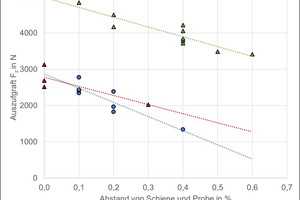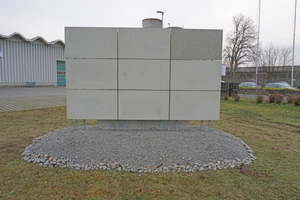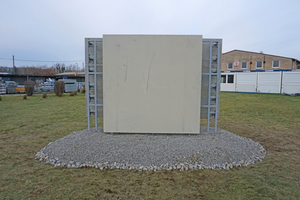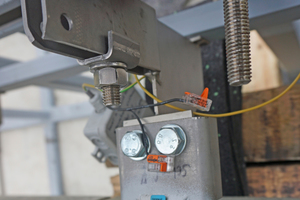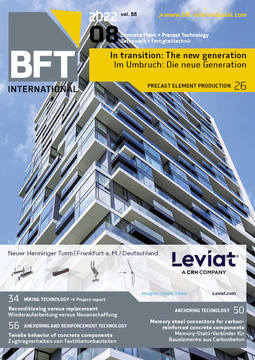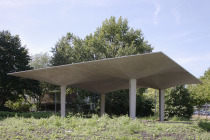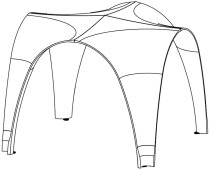Memory steel connectors for carbon-reinforced concrete components
Solutions for fastening and connecting thin-walled carbon-reinforced concrete structures were tested within the framework of a research project on “Thermally Activated Connecting Elements in Modular Construction”. Carbon-reinforced concrete is increasingly becoming the focus of attention in the construction industry as an innovative alternative to standard reinforced concrete.
A new type of connector for thin-walled carbon-reinforced concrete components was developed on the basis of shape memory alloys and used as a stable, force-locked and linear connection for large façade elements made of carbon-reinforced concrete. Solutions for fastening and connecting thin-walled carbon-reinforced concrete structures were tested within the framework of the TAVIMBA (thermally activated connecting elements in modular construction) research project. Due to its sustainable, resource-efficient and material-saving properties, carbon-reinforced concrete is increasingly becoming the focus of attention in the construction industry as an innovative alternative to standard reinforced concrete.
1 Introduction
Connecting precast concrete elements must be rethought when it comes to thin-walled components. New types of reinforcement, which require less concrete cover, offer an opportunity to use innovative concepts and materials for load application and anchorage in the concrete matrix. The load application area in these connecting elements is critical for the establishment of new slender structures made possible by using carbon-reinforced concrete. Current fastening systems consist either of complex multi-part elements [1], which allow the load to be applied in a single direction, or of undercut anchors (hanging profiles) latching onto a frame [2, 3].
Both systems require an installation effort behind the façade panels in order to align and secure the panels. The use of innovative memory steel connectors based on shape memory alloys aims to minimize the installation effort required behind the façade panel and to reduce the number of connecting elements while at the same time maintaining flexibility for adjustment on the construction site.
2 Material
Shape memory alloys are characterized by the ability to take on a previous shape independently by means of applying thermal energy. Within the framework of the research project, an alloy was used which, after mechanical forming in the martensitic state (at room temperature), returns to the original shape of the component prior to the forming process. This one-way effect is suitable for connecting elements such as shrink sleeves [4].
When the iron-based shape memory alloy (Fe-28Mn-6Si-5Cr) used is formed at low temperatures, dislocations develop in the martensitic phase, where large distances can be covered without the loss of neighboring atomic relationships. When the material is subsequently heated, the positively charged atomic cores move back in the direction of their former neighbor. Depending on the alloy used, this effect can amount to several percent of the original length.
3 Connectors
A 30-mm thick suspended façade panel of carbon-reinforced concrete is installed as a constraint for the connection concept. Such thin-walled panels are firmly fastened to the load-bearing exterior wall by means of shape memory alloy connectors. The load transfer between the façade panel and connecting pin is effected via modified Jordahl mounting channels [5, 6] that are firmly connected to the concrete by means of an anchorage system developed for thin building elements.
After the forming process (Fig. 1a), the non-activated pin is inserted in the mounting channel (Fig. 1b). In the next step, the shape memory alloy connector is activated by supplying external power to an internal heating element. Increasing the temperature of the connector then leads to an activation of the shape memory alloy and to a firm connection between the connecting pin and the mounting channel due to a longitudinal expansion of the shape memory alloy pins (Fig. 1c).
4 Experimental testing
Various prototypes were manufactured and then tested using different physical fastening systems. Based on these initial results, the focus was then placed on a preferred variant. Parallel to the experimental test results, simulation models were created in order to visualize and effectively optimize mechanical modes of action [7]. A tensile test (Fig. 4, blue “tensile test 1xH” characteristic) was the starting point for the optimization steps shown as examples below.
The results of the numerical simulation show an incomplete use of the functional area in terms of height. As a result of the strain acting against the sides of the mounting channel used, these bend in a V-shape, thus making only the lower part of the functional surface usable for the connection (Fig. 3).
This finding initiated a new design of the contact surface with specimens of reduced height. In a single optimization step, it was thus possible to save 30 % on material without significantly influencing the action of the connecting pins (Fig. 4, dark red “tensile test 0.7xH” characteristic). The material saved was invested in an extension of the specimen in order to be able to absorb higher shear stresses with the same material input and thus increase the safety of fastening the façade panels (Fig. 4, green “tensile test 0.7xH, length x1,5” characteristic).
The findings obtained under laboratory conditions were used in various field tests in order to be able to make precise assessments regarding use under real-life conditions. One example of an experimental setup fully models the new parameters of the memory steel connectors (Fig. 5) and demonstrates the practical feasibility of the newly developed connection concept for extremely thin façade panels. Each side of this setup represents different applications in façade construction. One side holds nine small façade panels (1.2 m x 0.9 m x 0.03 m). This panel arrangement puts the adjustability of the overall concept to the test. The possibility to shift the facing bracket [8] used as a link between frame and façade panel by several centimeters and in three spatial directions allows the façade panels to be easily aligned relative to their neighboring panels. It is in particular the compact design of the facing bracket that adds further benefits to the overall concept compared with conventional façade fastening systems, such as the installation of inner façade panels without having to remove their neighbors. The second side of the field test setup carries a large façade panel (2.4 m x 2.4 m x 0.03 m) that is retained by no more than four connectors. This large cross-story façade panel specifies the load case, which was transferred to the nine small façade panels.
The shape memory alloy connectors are not activated in advance in the laboratory but during installation and without mechanical accessibility. A heating cartridge is inserted into the connector bores, which heats the connectors electrically by means of wires. In this test setup, adequate heating of the connectors was verified by means of adhesive temperature indicators (Fig. 6).
Anchoring the channel to the façade panel has been implemented conventionally using small head studs. This overall concept showed an excellent performance in laboratory tests for the load case under evaluation [9]. Outdoor installation exposes the innovative connection system to the effects of all types of weather. The effects of corrosion on the connection system are under long-term observation in this and additional field tests. The results obtained will be incorporated into the optimization processes and improvement of the connector.
5 Conclusion
Based on the investigations conducted, using shape memory alloy connectors as active connectors offers an alternative for load application in thin-walled concrete elements with high pull-out values in relation to the material input. The symbiosis of laboratory tests and accompanying simulation permits the parameters of use to be effectively optimized. This was exemplified on the specimen geometry side. The potential inherent in the process of shape change unfolds in field tests.
It is now possible to install façade panels without having physical access to the joint. This results in increased safety for the staff performing the work on the construction site. Due to the compact connection between the load-bearing components and the façade panel, inner elements can be replaced separately without having to dismantle the neighboring façade panels. With its high manganese content, the selected iron-based shape memory alloy exhibits high resistance to corrosion. Combined with other protective measures, such as galvanizing or the use of stainless steels between the load-bearing components and shape memory alloy, the overall connection concept has so far shown good resistance to the inclemencies of weather.
The project that this report is based on was realized in collaboration between Pohlcon GmbH (Jordahl division), the Institute of Concrete Structures at Dresden University of Technology, Fraunhofer Institute for Machine Tools and Forming Technology, and Carbocon GmbH as project partners. It was funded by the Federal Ministry of Education and Research (Bundesministerium für Bildung und Forschung) under grant number 03ZZ1038A. The authors are responsible for the content of this publication.

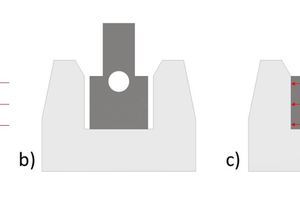
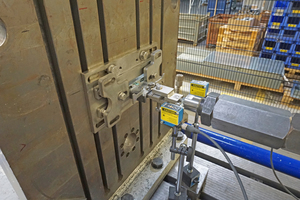
![Fig. 3: Incomplete use of the functional area [cf. 7]](https://www.bft-international.com/imgs/1/8/2/2/1/4/1/tok_74dc0d14808093b15eac566d2e72d925/w300_h200_x600_y335_HA_1169_Fig.3_Druck_mS_b-92811356bde3cd51.jpeg)
